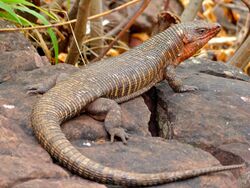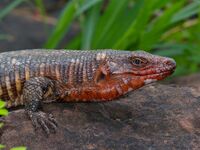Biology:Giant plated lizard
| Giant plated lizard | |
|---|---|

| |
| Scientific classification | |
| Domain: | Eukaryota |
| Kingdom: | Animalia |
| Phylum: | Chordata |
| Class: | Reptilia |
| Order: | Squamata |
| Family: | Gerrhosauridae |
| Genus: | Gerrhosaurus |
| Species: | G. validus
|
| Binomial name | |
| Gerrhosaurus validus A.Smith, 1849
| |
| Synonyms | |
| |
The giant plated lizard (Gerrhosaurus validus) is a lizard in the family Gerrhosauridae, which is found in dry to mesic habitats of southern Africa. They are wary and stay close to their rocky retreats.[1]
Subspecies
Two subspecies are recognised:
- Gerrhosaurus validus maltzahni
- Gerrhosaurus validus validus
Physical attributes
File:Wuppertal - Zoo - Gerrhosaurus validus 01 (0) ies.webm A large lizard with a flattened head and body, its length is a maximum of 75 cm (29.5 in). The soles of the feet have black rubber-like balls, an adaptation to living on rock outcrops. It is called the plated lizard because of the platelike scales on the back.[2] This lizard is very shy and hard to approach. When threatened, it will jam itself into rock crevices (aided by its flattened body) and inflate with air, making it impossible to extricate it.
It is omnivorous, consuming a fair amount of plant matter in addition to insects and even baby tortoises. It also tends to form loose colonies.[3]
References
Wikidata ☰ Q3061063 entry


